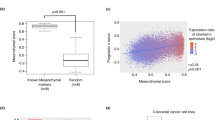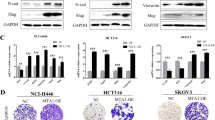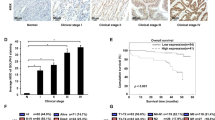Abstract
Epithelial–mesenchymal transition (EMT) has a major role in cancer progression, as well as normal organ development and human pathology such as organ fibrosis and wound healing. Here, we performed a gene expression array specialized in EMT of colorectal cancer (CRC). From a comprehensive gene expression analysis using epithelial- and mesenchymal-like CRC cell lines, and following the ontology (GO) analysis, SIX1 gene was identified to be an EMT-related gene in CRC. Using SW480 cells stably transfected with a SIX1 expression construct and their control counterparts, we demonstrated that SIX1 overexpression represses CDH1 expression and promotes EMT in CRC. SIX1-induced CDH1 repression and EMT in CRC cells were correlated at least in part with posttranscriptional ZEB1 activation and miR-200-family transcriptional repression. In primary tumors of CRC, in accord with the functional findings, aberrant expression of SIX1 in cancer cells was observed at the disruption of the basement membrane and at the tumor invasive front, where tumor cells underwent EMT in vivo. Taken together, SIX1 overexpression is suggested to occur in carcinogenesis, and contribute to repression of CDH1 expression and promotion of EMT partly through repression of miR-200-family expression and activation of ZEB1 in CRC.
This is a preview of subscription content, access via your institution
Access options
Subscribe to this journal
Receive 50 print issues and online access
$259.00 per year
only $5.18 per issue
Buy this article
- Purchase on Springer Link
- Instant access to full article PDF
Prices may be subject to local taxes which are calculated during checkout






Similar content being viewed by others
References
Batlle E, Sancho E, Francí C, Domínguez D, Monfar M, Baulida J et al. (2000). The transcription factor snail is a repressor of E-cadherin gene expression in epithelial tumour cells. Nat Cell Biol 2: 84–89.
Behbakht K, Qamar L, Aldridge CS, Coletta RD, Davidson SA, Thorburn A et al. (2007). Six1 overexpression in ovarian carcinoma causes resistance to TRAIL-mediated apoptosis and is associated with poor survival. Cancer Res 67: 3036–3042.
Brabletz S, Bajdak K, Meidhof S, Burk U, Niedermann G, Firat E et al. (2011). The ZEB1/miR-200 feedback loop controls Notch signalling in cancer cells. EMBO J 30: 770–782.
Brabletz S, Brabletz T . (2010). The ZEB1/miR-200 feedback loop—a motor of cellular plasticity in development and cancer? EMBO Rep 11: 670–677.
Brabletz T, Jung A, Reu S, Porzner M, Hlubek F, Kunz-Schughart LA et al. (2001). Variable beta-catenin expression in colorectal cancers indicates tumor progression driven by the tumor environment. Proc Natl Acad Sci USA 98: 10356–10361.
Bracken CP, Gregory PA, Kolesnikoff N, Bert AG, Wang J, Shannon MF et al. (2008). A double-negative feedback loop between ZEB1-SIP1 and the microRNA-200 family regulates epithelial–mesenchymal transition. Cancer Res 68: 7846–7854.
Buck E, Eyzaguirre A, Barr S, Thompson S, Sennello R, Young D et al. (2007). Loss of homotypic cell adhesion by epithelial–mesenchymal transition or mutation limits sensitivity to epidermal growth factor receptor inhibition. Mol Cancer Ther 6: 532–541.
Burk U, Schubert J, Wellner U, Schmalhofer O, Vincan E, Spaderna S et al. (2008). A reciprocal repression between ZEB1 and members of the miR-200 family promotes EMT and invasion in cancer cells. EMBO Rep 9: 582–589.
Cano A, Pérez-Moreno MA, Rodrigo I, Locascio A, Blanco MJ, del Barrio MG et al. (2000). The transcription factor snail controls epithelial–mesenchymal transitions by repressing E-cadherin expression. Nat Cell Biol 2: 76–83.
Coletta RD, Christensen KL, Micalizzi DS, Jedlicka P, Varella-Garcia M, Ford HL . (2008). Six1 overexpression in mammary cells induces genomic instability and is sufficient for malignant transformation. Cancer Res 68: 2204–2213.
Coletta RD, Christensen Z, Reichenberger KJ, Lamb J, Micomonaco D, Huang L et al. (2004). The Six1 homeoprotein stimulates tumorigenesis by reactivation of cyclin A1. Proc Natl Acad Sci USA 101: 6478–6483.
Comijn J, Berx G, Vermassen P, Verschueren K, van Grunsven L, Bruyneel E et al. (2001). The two-handed E box binding zinc finger protein SIP1 downregulates E-cadherin and induces invasion. Mol Cell 7: 1267–1278.
Eger A, Aigner K, Sonderegger S, Dampier B, Oehler S, Schreiber M et al. (2005). DeltaEF1 is a transcriptional repressor of E-cadherin and regulates epithelial plasticity in breast cancer cells. Oncogene 24: 2375–2385.
Ford HL, Kabingu EN, Bump EA, Mutter GL, Pardee AB . (1998). Abrogation of the G2 cell cycle checkpoint associated with overexpression of HSIX1: a possible mechanism of breast carcinogenesis. Proc Natl Acad Sci USA 95: 12608–12613.
Hajra KM, Chen DY, Fearon ER . (2002). The SLUG zinc-finger protein represses E-cadherin in breast cancer. Cancer Res 62: 1613–1618.
Haruki S, Imoto I, Kozaki K, Matsui T, Kawachi H, Komatsu S et al. (2010). Frequent silencing of protocadherin 17, a candidate tumour suppressor for esophageal squamous cell carcinoma. Carcinogenesis 31: 1027–1036.
Hoshino H, Miyoshi N, Nagai K, Tomimaru Y, Nagano H, Sekimoto M et al. (2009). Epithelial–mesenchymal transition with expression of SNAI1-induced chemoresistance in colorectal cancer. Biochem Biophys Res Commun 390: 1061–1065.
http://ganjoho.ncc.go.jp/public/statistics/backnumber/2009_en.html CANCER STATISTICS IN JAPAN ’09.
Iwatsuki M, Mimori K, Yokobori T, Ishi H, Beppu T, Nakamori S et al. (2010). Epithelial–mesenchymal transition in cancer development and its clinical significance. Cancer Sci 101: 293–299.
Jemal A, Siegel R, Xu J, Ward E . (2010). Cancer statistics, 2010. CA Cancer J Clin 60: 277–300.
Khanna C, Khan J, Nguyen P, Prehn J, Caylor J, Yeung C et al. (2001). Metastasis-associated differences in gene expression in a murine model of osteosarcoma. Cancer Res 61: 3750–3759.
Kumar JP . (2009). The sine oculis homeobox (SIX) family of transcription factors as regulators of development and disease. Cell Mol Life Sci 66: 565–583.
Massague J . (1998). TGF-β signal transduction. Annu Rev Biochem 67: 753–791.
McCoy EL, Iwanaga R, Jedlicka P, Abbey NS, Chodosh LA, Heichman KA et al. (2009). Six1 expands the mouse mammary epithelial stem1/progenitor cell pool and induces mammary tumors that undergo epithelial–mesenchymal transition. J Clin Invest 119: 2663–2677.
Micalizzi DS, Christensen KL, Jedlicka P, Coletta RD, Barón AE, Harrell JC et al. (2009). The Six1 homeoprotein induces human mammary carcinoma cells to undergo epithelial–mesenchymal transition and metastasis in mice through increasing TGF-beta signaling. J Clin Invest 119: 2678–2690.
Micalizzi DS, Farabaugh SM, Ford HL . (2010a). Epithelial–mesenchymal transition in cancer: parallels between normal development and tumor progression. J Mammary Gland Biol Neoplasia 15: 117–134.
Micalizzi DS, Wang CA, Farabaugh SM, Schiemann WP, Ford HL . (2010b). Homeoprotein Six1 increases TGF-beta type I receptor and converts TGF-beta signaling from suppressive to supportive for tumor growth. Cancer Res 70: 10371–10380.
Muramatsu T, Imoto I, Matsui T, Kozaki K, Haruki S, Sudol M et al. (2011). YAP is a candidate oncogene for esophageal squamous cell carcinoma. Carcinogenesis 32: 389–398.
Ng KT, Man K, Sun CK, Lee TK, Poon RT, Lo CM et al. (2006). Clinicopathological significance of homeoprotein Six1 in hepatocellular carcinoma. Br J Cancer 95: 1050–1055.
Peinado H, Olmeda D, Cano A . (2007). Snail, Zeb and bHLH factors in tumour progression: an alliance against the epithelial phenotype? Nat Rev Cancer 7: 415–428.
Perl AK, Wilgenbus P, Dahl U, Semb H, Christofori G . (1998). A causal role for E-cadherin in the transition from adenoma to carcinoma. Nature 392: 190–193.
Rodriguez A, Sickles HM, DeLeonardis C, Alcaraz A, Gridley T, Lin DM . (2008). Notch2 is required for maintaining sustentacular cell function in the adult mouse main olfactory epithelium. Dev Biol 314: 40–58.
Roy HK, Smyrk TC, Koetsier J, Victor TA, Wali RK . (2005). The transcriptional repressor SNAIL is overexpressed in human colon cancer. Dig Dis Sci 50: 42–46.
Spaderna S, Schmalhofer O, Hlubek F, Berx G, Eger A, Merkel S et al. (2006). A transient, EMT-linked loss of basement membranes indicates metastasis and poor survival in colorectal cancer. Gastroenterology 131: 830–840.
Tanami H, Tsuda H, Okabe S, Iwai T, Sugihara K, Imoto I et al. (2005). Involvement of cyclin D3 in liver metastasis of colorectal cancer, revealed by genome-wide copy-number analysis. Lab Invest 9: 1118–1129.
Thiery JP . (2002). Epithelial–mesenchymal transitions in tumour progression. Nat Rev Cancer 2: 442–454.
Thiery JP, Acloque H, Huang RY, Nieto MA . (2009). Epithelial–mesenchymal transitions in development and disease. Cell 139: 871–890.
Wan F, Miao X, Quraishi I, Kennedy V, Creek KE, Pirisi L . (2008). Gene expression changes during HPV-mediated carcinogenesis: a comparison between an in vitro cell model and cervical cancer. Int J Cancer 123: 32–40.
Wellner U, Schubert J, Burk UC, Schmalhofer O, Zhu F, Sonntag A et al. (2009). The EMT-activator ZEB1 promotes tumorigenicity by repressing stemness-inhibiting microRNAs. Nat Cell Biol 11: 1487–1495.
Yang J, Weinberg RA . (2008). Epithelial–mesenchymal transition: at the crossroads of development and tumor metastasis. Dev Cell 14: 818–829.
Yu Y, Davicioni E, Triche TJ, Merlino G . (2006). The homeoprotein six1 transcriptionally activates multiple protumorigenic genes but requires ezrin to promote metastasis. Cancer Res 66: 1982–1989.
Yu Y, Khan J, Khanna C, Helman L, Meltzer PS, Merlino G . (2004). Expression profiling identifies the cytoskeletal organizer ezrin and the developmental homeoprotein Six-1 as key metastatic regulators. Nat Med 10: 175–181.
Zheng W, Huang L, Wei ZB, Silvius D, Tang B, Xu PX . (2003). The role of Six1 in mammalian auditory system development. Development 130: 3989–4000.
Acknowledgements
This study was supported by grants-in-aid for Scientific Research (A), (B) (C) and on Priority Areas, and the Global Center of Excellence (GCOE) Program; International Research Center for Molecular Science in Tooth and Bone Diseases from the Ministry of Education, Culture, Sports, Science, and Technology, Japan; a Health and Labour Sciences Research Grant from the Ministry of Health, Labour and Welfare, Japan; and a grant from the New Energy and Industrial Technology Development Organization (NEDO). We thank Yoko Takagi, Ayako Takahashi, Rumi Mori and Kathy Masker for technical assistance.
Author information
Authors and Affiliations
Corresponding author
Ethics declarations
Competing interests
The authors declare no conflict of interest.
Additional information
Supplementary Information accompanies the paper on the Oncogene website
Supplementary information
Rights and permissions
About this article
Cite this article
Ono, H., Imoto, I., Kozaki, K. et al. SIX1 promotes epithelial–mesenchymal transition in colorectal cancer through ZEB1 activation. Oncogene 31, 4923–4934 (2012). https://doi.org/10.1038/onc.2011.646
Received:
Revised:
Accepted:
Published:
Issue Date:
DOI: https://doi.org/10.1038/onc.2011.646
Keywords
This article is cited by
-
Retinal determination gene networks: from biological functions to therapeutic strategies
Biomarker Research (2023)
-
RETRACTED ARTICLE: Lymphatic metastasis-related TBL1XR1 enhances stemness and metastasis in gastric cancer stem-like cells by activating ERK1/2-SOX2 signaling
Oncogene (2021)
-
SIX4 promotes hepatocellular carcinoma metastasis through upregulating YAP1 and c-MET
Oncogene (2020)
-
Circular RNA circNHSL1 promotes gastric cancer progression through the miR-1306-3p/SIX1/vimentin axis
Molecular Cancer (2019)
-
The integrative knowledge base for miRNA-mRNA expression in colorectal cancer
Scientific Reports (2019)



